CHAPTER 9
Firearm Retention and Professional Kravist Weapon-Defense Drills
Sidearm Retention
Sidearm retention is a foremost concern for law enforcement, military, and other lawfully armed personnel. For sidearm retention, before the assailant can grab the defender’s weapon, krav maga uses basic deflection-redirection defenses with a 180-degree hip pivot to take the gun-side hip away while simultaneously striking the assailant or creating distance.
If the assailant successfully grabs the defender’s holstered weapon, the simultaneous defense and attack principle dictates that with a typical level 3 or 4 retention holster, the defender must secure the weapon with preferably his forearm or, if necessary, his hand or by pressing against the top rear of the slide while delivering combatives with the free arm, legs, and possibly head butts. In the case of a tactical thigh rig, both hands may be needed to secure the weapon, necessitating knee strikes or kicks while turning the gun leg away from the assailant and tucking the chin to protect the throat.
Sidearm Retention, Twelve O’Clock Threat
This defensive option intercepts someone attempting to grab your firearm from your twelve o’clock.

With your nearside (weapon-side) arm, use a modified forearm chop/rotation to deflect the assailant’s reaching arm.

As you ward off the assailant’s incoming arm, pivot 180 degrees, using tai-sabaki. At the same time, use your opposite arm to deliver a strike to the assailant’s head. As you do so, immediately create distance for a higher use-of-force option or, alternatively, close on the assailant to detain him.
Sidearm Retention, Three O’Clock Threat
This defense, by design, is similar to previous sidearm frontal retention techniques.

With your nearside (weapon-side) arm, use a modified forearm chop/rotation to deflect the assailant’s reaching arm.

As you ward off the assailant’s incoming arm, pivot 180 degrees, using tai-sabaki. As you pivot, use your opposite arm to deliver a strike to the assailant’s head.

As you strike the assailant, immediately create distance and deploy your sidearm.
Sidearm Retention, Three O’Clock Threat (Thigh Holster Variation)
This defense, by design, is similar to previous sidearm frontal retention techniques.

With your nearside (weapon-side) arm, use a modified forearm chop/rotation to deflect the assailant’s reaching arm.

As you ward off the assailant’s incoming arm, pivot 180 degrees, using tai-sabaki. At the same time, use your opposite arm to deliver a strike to the assailant’s head. As you strike the assailant, immediately create distance and deploy your sidearm.

Maintain your distance to control the situation with a clear field of fire.
Sidearm Retention, Six O’Clock Threat
This defense is appropriate if an assailant is able to “get the drop” on you or approach you from the rear undetected and attempt to grab your sidearm.
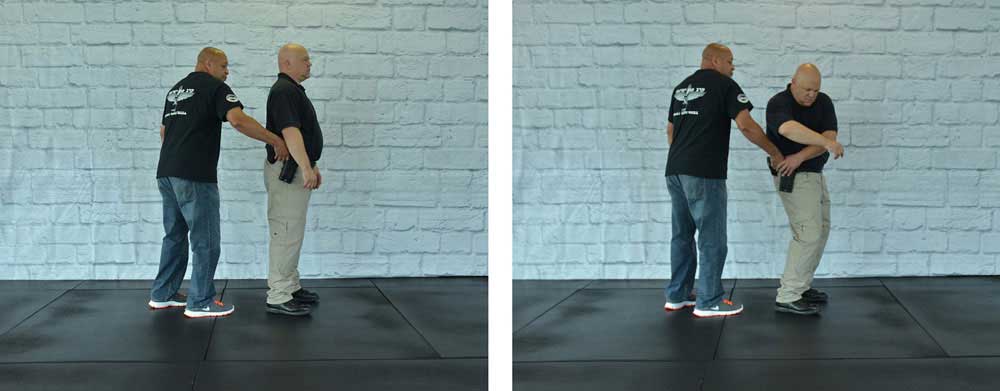
Defend initially with your nearside (weapon-side) arm by clamping down on, or delivering a compact elbow strike to, his reach hand. If the assailant succeeds in grabbing your pistol grip, use your left hand to clamp down hard, smashing his thumb or the top of his hand. As you ward off the assailant’s incoming arm, pivot 180 degrees, using tai-sabaki.
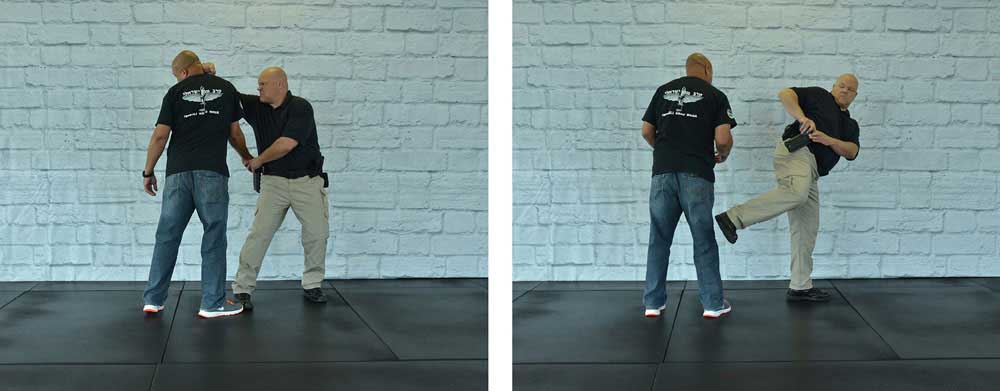
As you pivot, use your right nearside arm to deliver a strike to the assailant’s head.

You may further debilitate him with a side kick to his knee. After you stun the assailant, immediately create distance for a higher use-of-force option or, alternatively, close on the assailant to detain him.
Sidearm Retention, Six O’Clock Threat (Alternative #1)
If an assailant is able to “get the drop” on you or approach you from the rear undetected and attempt to grab your sidearm, another defensive option is to clamp down with your weapon-side arm and wheel around to strike him in the head.

Clamp down with your weapon-side arm on top of the holster or the assailant’s hand.

Continue to clear his hand from your holster by turning clockwise to face the threat. Note: another option (not depicted) is to clamp down with your weapon-side forearm and turn your head over your other shoulder to club the assailant with your free arm. As you club him, pivot away to gain distance and release his hand from your holstered weapon.

As you clear the threat, continue to take a tai-sabaki step while simultaneously delivering a strike to the assailant’s head.

Create distance and deploy your sidearm to control the threat or, alternatively, close on the assailant to detain him.
Sidearm Retention, Six O’Clock Threat (Alternative #2)
This third option is similar to the previous defense. Use it if an assailant “gets the drop” on you or approaches undetected from the rear and attempts to grab your sidearm. Clamp down and wheel around to strike him in the head.

Clamp down with your weapon-side arm on top of the holster or the assailant’s hand.

Continue to clear his hand by delivering an elbow to his midsection, solar plexus, or chin. Create distance and deploy your sidearm to control the threat or, alternatively, close on the assailant to detain him.
Deployed Sidearm Retention, Twelve O’Clock Grab Attempt
If you have your handgun deployed and, for whatever reason, do not want to shoot an assailant attempting to grab it, a weapon-retention option is to rotate the weapon in a small semicircle to avoid his grasp while simultaneously using the handgun as a cold weapon. You may also, of course, simply strike him directly in the face with the weapon to preempt his grab attempt.

If the assailant takes advantage of a negative-five situation to close the distance on you and reach for your deployed sidearm, you may thwart his attempt by rotating your weapon counterclockwise in a tight circle (usually preferable for right-handed shooters) or clockwise (usually preferable for left-handed shooters).
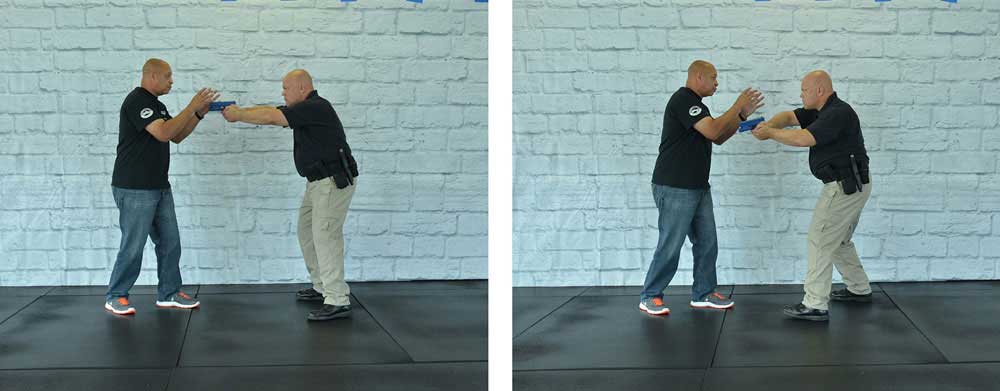
As you rotate the weapon to prevent him from grasping it, continue with your tight loop to use it as a cold weapon to attack the assailant’s head. Note: you can use your two-handed firing grip or release your weak-side hand to better control the firearm as a cold weapon.

Forcefully strike the assailant in the head with the barrel. An alternative strike is to remove your support hand and use it to support the barrel strike to the assailant’s head. Continue with retzev combatives or create distance for a clear field of fire.
Deployed Sidearm Retention, Twelve O’Clock Threat (Assailant’s Hands on Your Weapon)
If the assailant is able to place his hands on your sidearm, a strong retention tactic is to pull your elbows close to your torso while stepping forcefully with your nearside leg in front of the assailant to make him relinquish his grip. If for whatever reason you do not want to shoot an assailant who is able to place his hands on your weapon, a weapon-retention option is to step forward strongly while raising your elbow, which simultaneously points the barrel down and away.

Raise your right elbow and step with your right leg forward to “punch” your shoulder into the assailant to facilitate removing his grip. Jolt the assailant with your nearside shoulder to create further separation.

Use the handgun as a cold weapon or use a lower-body combative to debilitate the assailant. As you release his grip, immediately go on the counteroffensive by using the handgun as a cold weapon to strike the assailant in the head. Or use lower-body combatives to create distance and discharge the firearm into the assailant—as legally justified and necessary. The key is not to let the assailant attack or take your back.

Finish as necessary with additional combatives such as the front kick depicted, or create distance to control the situation and use the firearm as needed.
Note: you could also step forward with your left leg and pull the weapon back to face the assailant and not turn your back. The advantage of this is that you have the barrel still facing the assailant. However, the nearside leg stepping forward is depicted because it is a stronger option for a smaller person against a much larger, possibly more powerful assailant and is also used similarly for long-gun retention in a similar situation.
Long-Gun or Submachine Gun Weapon Retention, Twelve O’Clock Kick Option
Instinctively, a defender usually will not willingly let go of or give up his weapon. Obviously, your first optimum reaction is to shoot the assailant. The following long-gun defenses assume you cannot take the initial shot.
Krav maga, as with most of its other tactics, builds on this instinct to maintain or wrest control away from the assailant. The defense, similar by design to most krav maga defenses, parallels an unarmed “bear hug” defense with the arms free.
If the assailant attempts to grab the long gun from the rear while the defender’s arms are raised with the weapon in either the low or high ready rifle positions, the defender will naturally take a step forward or back. Importantly, from a low ready rifle position, if the assailant grabs the barrel, the defender can also drop to one knee, which will usually point the barrel directly at the assailant’s pelvis or midsection, allowing an effective shot. The direction of motion, in turn, usually depends on if the assailant is driving the defender forward or back. In one of krav maga’s few counterintuitive movements, the defender is encouraged to move with the assailant rather than resist him. Long-gun or SMG retention, with or without a sling, uses the simple concept of turning the assailant’s force against him as he attempts to wrest the weapon away.
By using leverage and footwork combined with barrel rotations, the defender can disengage the weapon from the assailant’s grip. Against a right-hand grab of the muzzle, it is recommended to rotate the barrel or muzzle clockwise while stepping forward. This is followed by a rifle combative or low-line kick, or by stepping backward to free the weapon and possibly shooting the assailant. If the assailant grabs the barrel with his left hand, rotate the barrel clockwise while stepping forward with combatives. Or step backward to disengage and then shoot. The long gun or SMG is also turned trigger side in to break the assailant’s grip. At the same time, you turn the magazine in to the assailant, clearing the way for kicks and knee counterstrikes.
Alternatively, if your long gun is slung and the assailant has grabbed it, you may close on the assailant to collar-tie clinch him while transitioning to a secondary weapon or to attack his head. This could include a thumb gouge to his same-side eye or a forceful manipulation of his neck. Move with the assailant as he pulls at your weapon to harness his momentum and your momentum and seize control of his head. For the clinch, even though he may have your primary weapon in his hands, you must account for his ability to fight back and possibly seize your secondary weapon, including an edged weapon.
The collar-tie clinch allows you to control the assailant’s head and keep him close, but be aware of the possible countermeasures he may use. The goal is to get one of your weapons on line while exerting maximum control of the assailant or, if possible, to create enough separation to deploy your primary or secondary firearm. Note: of course, a defender can use weapon-retention or cold combatives and then go “hot.”
Long-gun or SMG retention, with or without a sling, uses the simple concept of turning the assailant’s force against him as he attempts to wrest the weapon away. By moving in the direction of the weapon pull, the defender’s momentum increases the power and effectiveness of the strikes.

Move in the direction in which the adversary pulls the weapon, harnessing his momentum and your momentum against him. This will enhance the power and effectiveness of your lower-body strikes.

It is important to rotate your long gun’s magazine housing into the assailant, as this provides you with a much stronger grip and clears the magazine for your lower-body combatives. (Note: krav maga uses the technique of rotating the magazine housing into the opponent when using a disarming technique against him.) Immediately create distance with a clear field of fire.
Long-Gun or Submachine Gun Weapon-Retention Rotations

The long gun’s grips are obviously designed for the shooter to maintain control. By forcefully rotating the weapon clockwise, the assailant will have a difficult time holding on to it.

Beginning position.

Rotation 2.

Rotation 3.


Continue to rotate the long gun clockwise to clear it and create a clear field of fire.
Twelve O’Clock Grab When an Assailant Wrenches the Slung Weapon Away into Clinch and the Defender Has a Sidearm
Your instinct, most likely, is not to let go of your weapon. Yet if the assailant succeeds in grasping it and wrenching it partially or fully from your grip, a weapon-retention option—provided your weapon has a sling and you have a functional sidearm—is to use a one-armed, crown-of-the-head clinch to secure the assailant while deploying your sidearm to shoot him. This tactic is obviously only available to those who have a sidearm, although the defender could also deploy a blade to counterattack.

As the assailant pulls your weapon, keep it secured with your shooting hand, using the sling for weapon-retention reinforcement. Clinch the back of his head with your left arm. Similar to the previous defense, it is important to harness the assailant’s momentum as he pulls backward in an attempt to pull your long gun away.

Once you have the assailant firmly clinched with your left hand, transition to your handgun.

Use a point-shoot method to neutralize the assailant. Note: a few methods of shooting the assailant may be used, and it is up to one’s individual preference.
Long-Gun Weapon Retention While Defending Takedown Attempts
Long-Gun Strikes against Tackle Attempts
Against a rear tackle attempt, the defender (using correct timing and distance) has a few options depending on his recognition of the incoming attack and its angle. Fortunately, an operator’s equipment and weapon at the ready position can make it difficult for an assailant of average size to wrap his arms around the defender.
Twelve O’Clock Tackle Attempt
Against a front tackle attempt, the defender, using correct timing and distance, has a few options—besides shooting the onrushing assailant:
- Thrust the muzzle into the assailant’s face or throat.
- Sidestep the attack and slash down on the assailant’s head with the muzzle.
- Extend the foregrip or magazine into the assailant’s carotid sheath or neck by using a subtle sidestep while maintaining a strong body posture and position to thwart the attack.
- Sprawl with the weapon raised high, maintaining your weight on the assailant’s neck to bury his head into the ground and continue your counterattacks.
Note: it is also possible to deliver a preemptive straight rear kick, a knee, or front sidekick to the assailant’s head if he is crouched, or to his body if he is more upright, before he can close on you to attempt a takedown. But a long gun is a highly effective tool, and it is better for the defender to keep his legs firmly planted on the ground with his weight on the balls of his feet.
Twelve O’Clock Modified Sprawl
If you do not have time to shoot him or perform one of the previously discussed options, you may have to use a modified sprawl.

From the low ready rifle position, as the assailant drops down in his front takedown attempt, angle your long gun with the muzzle to the ground. From a high ready rifle position, you would use your forearms and the weapon as an “A” frame or wedge as you sprawl.

As he closes on you, sprawl your legs backward with a wide base. Drive your weight into him. Try to remain on the balls of your feet rather than on the sides of your feet to facilitate your ability to get up quickly.

Use the assailant’s body to push yourself up, create separation, and use your long gun as necessary.
Long-Gun Retention Twelve O’Clock Tackle
This tactic is effective when an assailant is able to successfully come underneath your weapon, wrapping his arms around you to take you down.

You must fall break effectively with your back while maintaining solid control of your long gun.

As you fall break to the ground, immediately position your topside foreleg against the assailant to prevent him from mounting you while also allowing you to jolt him back to create separation. As you position your topside leg, try to place your bottom-side heel against his hip or thigh for the Z guard.
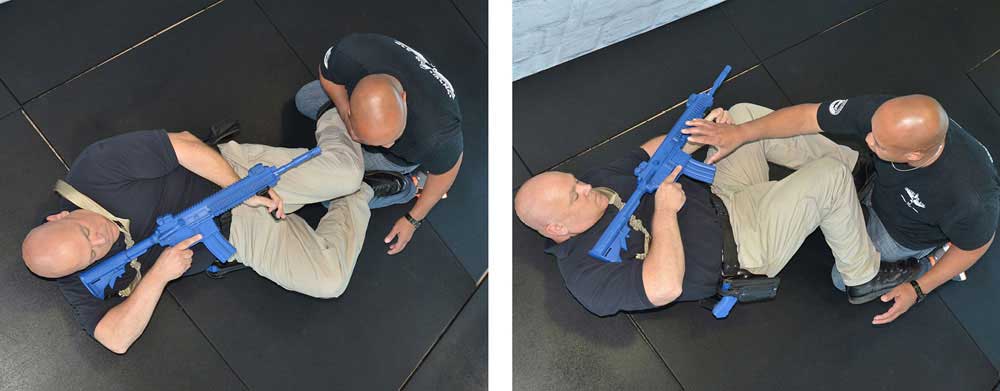
Control the assailant with your legs and bring your long gun online.

If the assailant continues to reach for your long gun, clamp it tight to your torso and transition to your sidearm (or an edged weapon). (Note: if you do not have a side arm, extend your legs to kick the assailant and create separation to allow you to use your long gun.)
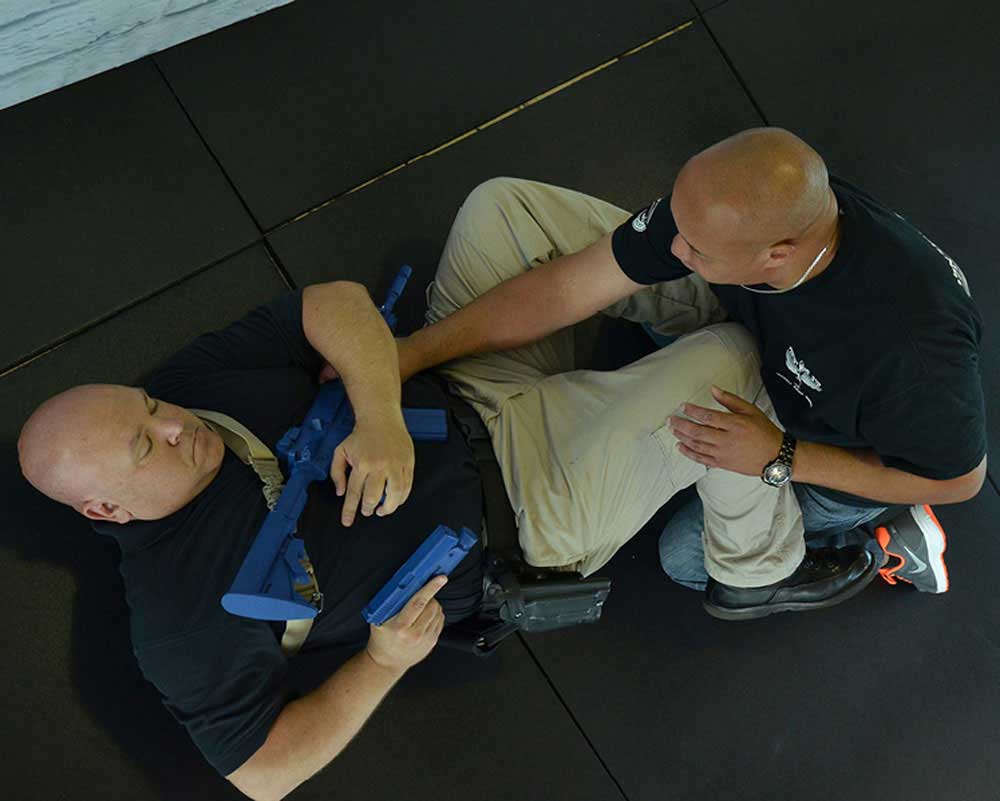
Use your sidearm as necessary.
Long-Gun Three O’Clock Retention
With early recognition, you may use clockwise rotations to defend against an assailant’s attempt to wrest your weapon from you. This is similar to the twelve o’clock retention technique.
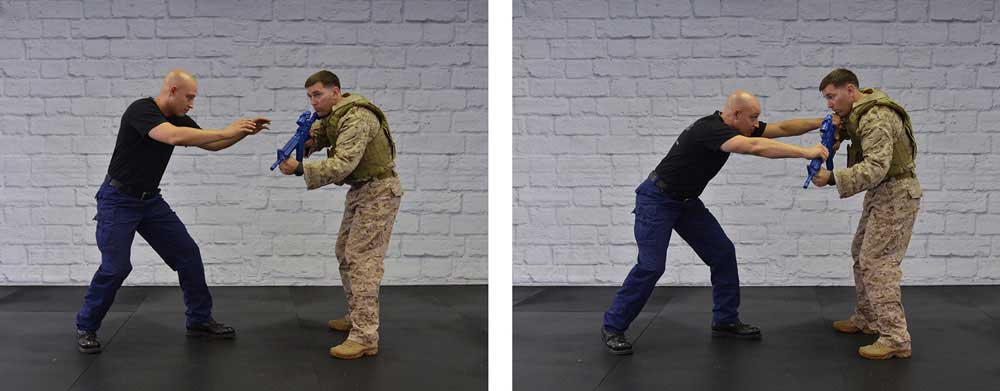
The long gun’s grips are obviously designed for the shooter to maintain control. By forcefully rotating the weapon clockwise, the assailant will have a difficult time holding on to it.

Continue to rotate the long gun clockwise to clear it and create a clear field of fire.
Long-Gun Four to Five O’Clock Retention
This is similar to the six o’clock retention. With early recognition, the defender may deliver a butt strike to the assailant’s head or, if the assailant is crouched, a rear heel kick to the assailant’s head and, if more upright, to the torso. If the defender’s recognition is late and he goes facedown, he must land (fall break) correctly and then instantaneously raise his rear knee (assuming he is a right-handed shooter) to transition 180 degrees to the foreleg brace position to keep the assailant momentarily at bay. Next he must disengage from the assailant and establish a solid shooting platform to use his primary or secondary weapon. Note: it is also possible to deliver a straight rear kick if the assailant is approaching from the liveside or front sidekick if the assailant is approaching from the deadside. In either case, the target is either the head, if he is crouched, or the body, if he is more upright. Note again, however, a long gun is a highly effective tool, and it is better for the defender to keep his legs firmly planted on the ground with his weight on the balls of his feet.

The long gun’s grips are obviously designed for the shooter to maintain control. By forcefully rotating the weapon clockwise, the assailant will have a difficult time holding on to it. Note: as an alternative, you can also deliver a short sidekick to the assailant’s right or left knee.

Continue to rotate the long gun clockwise to remove it from his grasp.

Create a clear field of fire.
Long-Gun Four to Five O’Clock Retention When Tackled
If you are ambushed from the rear with a tackle, you must recover quickly by falling correctly and then immediately turning to face the assailant.
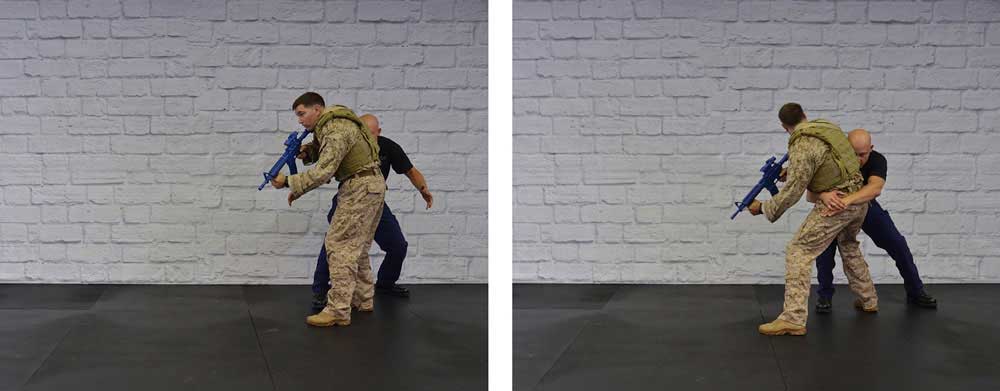
On first contact, as the assailant wraps his arms around you, swivel your head and begin to turn your front into him.
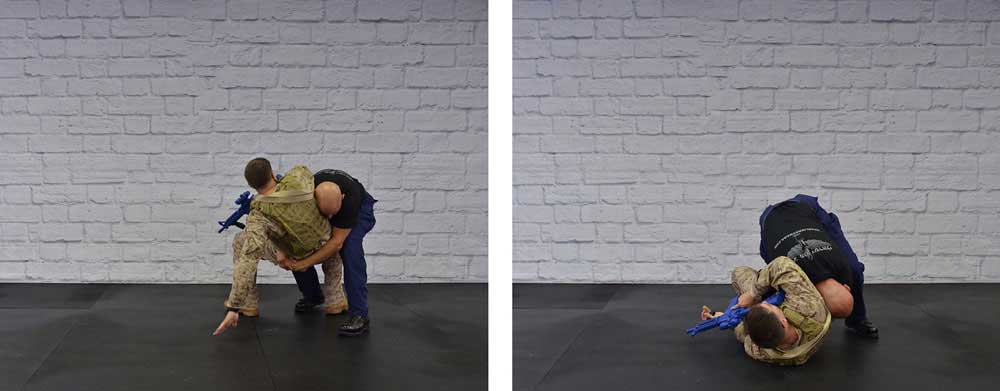
As you continue to turn but are driven back, lower your support arm to lessen the impact. Be sure to bend and angle both your wrist and arm slightly to avoid injuring them as your arm absorbs the combined weight of you and your assailant.

Land on your back and continue to turn into him. As soon as you make contact with the ground, secure your weapon with your support arm again and bridge into the assailant. Note: if you are so combat laden that you cannot easily turn into the assailant to pin him, you may, as an alternative, remain on your back, pivot your body 180 degrees (not depicted), and turn your legs toward him to ward him off for a stable firing platform.

Create separation, if possible landing on top of him or to his side to bring your long gun to bear.
Long-Gun Six O’Clock Retention
The attack here comes from behind, your six o’clock. With early recognition, the defender may deliver a butt stroke to the assailant’s head or, if the assailant is crouched, a rear heel kick to the assailant’s head, and if more upright, to the torso. Note again, however, a long gun is a highly effective tool, and it is better for you to keep your legs firmly planted on the ground with your weight slightly on the balls of your feet. If the assailant does succeed in closing on you from your six o’clock, react instantaneously by turning into him before he can secure his arms around you or your weapon.
Harnessing the assailant’s momentum obviously takes training. And if the defender is caught unaware, the assailant will move him in one direction or the other; the defender must simply flow with it. If the assailant drives the defender forward, the defender will step forward. Depending on which way the defender steps—forward or to the rear—the defender’s front or rear leg will be “loaded” as it takes his weight. When one leg is loaded, the other leg gains more freedom of action, such as to administer a punishing knee or kick. The weight transfer also allows the defender to pivot off the line of attack. As the defender pivots, he may use the long gun for a close-quarters battle point-shoot option or in a cold-weapon capacity.
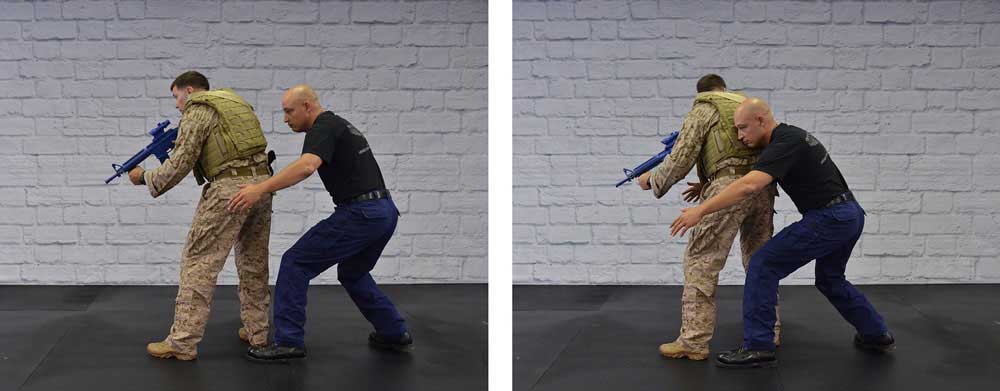

As the assailant makes contact, take a natural step forward to move with the initial jolt. Try, however, not to place all of your weight on your front leg. As you step, begin to take a step with your forward leg to the outside off the line of attack.

Turn away from him, beginning to break contact and separate.
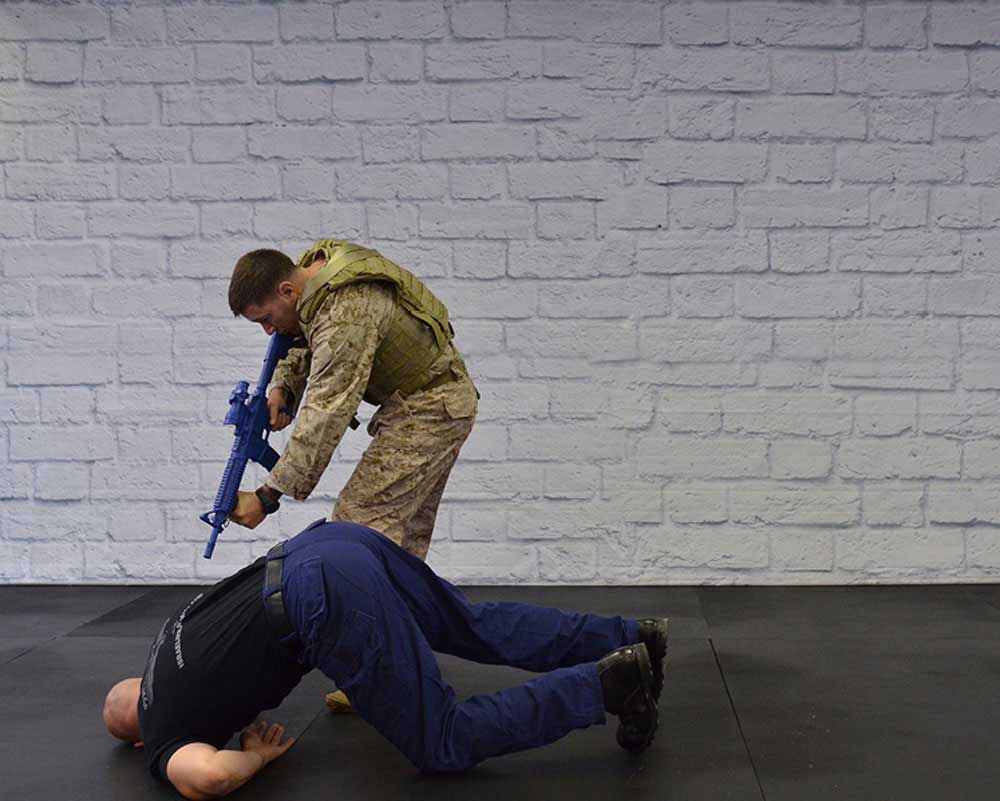
Create separation and bring your weapon to bear.
Long-Gun Retention Six O’Clock Tackle Attempt with the Defender in the Ready Position: Reverse Sprawl
If an assailant is able to approach you from your six o’clock position, you must build your defense on his forward momentum carrying you forward. If you recognize the impending attack just as he is about to latch onto you, you may perform a reverse topside or “face-up” sprawl, landing on the assailant’s head or upper torso. The additional weight of your armor, load-bearing vest, or helmet will aid in this. Quickly get up or transition 180 degrees to keep his front pinned to the ground, allowing you to continue counterattacks from an advantageous position.
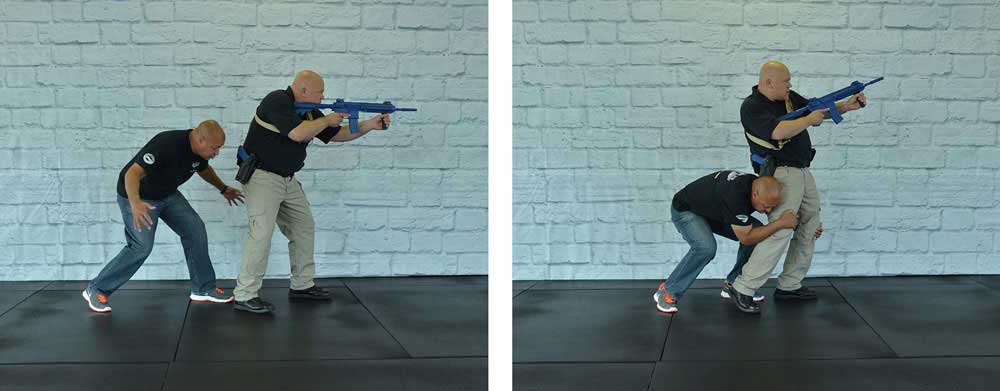
As the assailant makes contact, take a natural step forward with your rear leg or both legs to move with the initial jolt. Let both of your legs move forward.
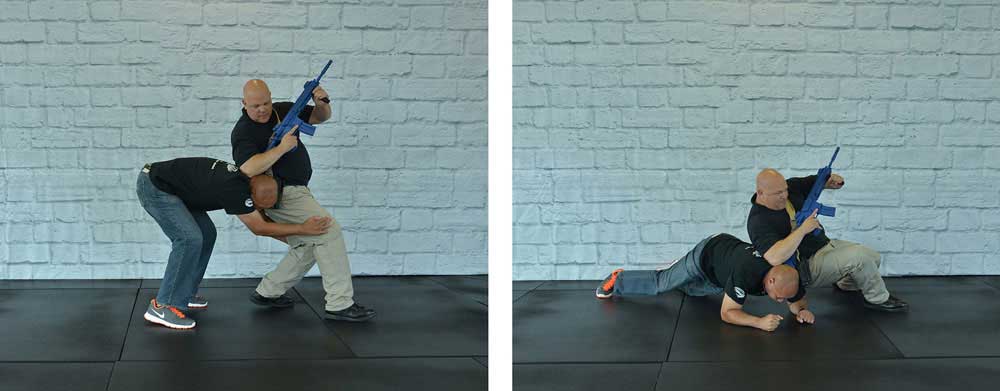
As you step forward, let your weight fall back, centering it on his neck and shoulder as he drives underneath you. “Reverse sprawl” with him and allow your legs to move forward slightly while driving your weight into him.

Use the butt of your long gun or your elbow to smash him in the head as you both descend. Get up immediately.

Bring your weapon to bear.
Long-Gun Retention Six O’Clock Tackle Attempt with the Defender in the Ready Position: Turn into the Foreleg Brace Position
If the assailant succeeds in ambushing you from your six o’clock position, move forward with the tackle to break the fall and immediately transition into the default foreleg brace position.
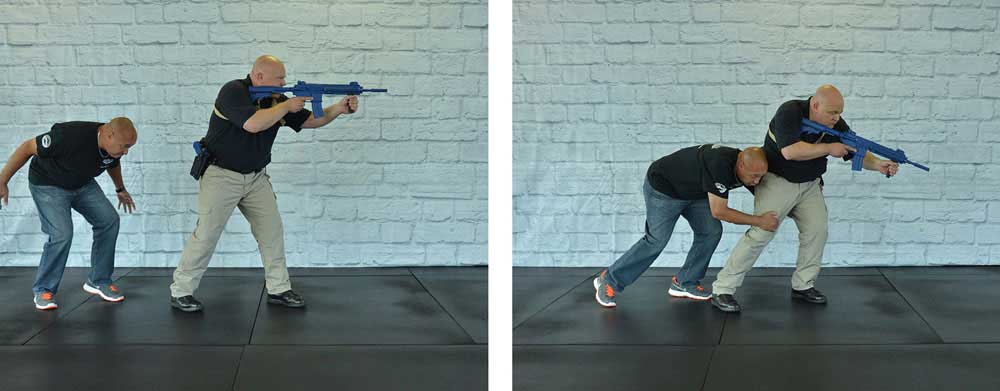
As the assailant makes contact, step forward to move naturally with his initial jolt.
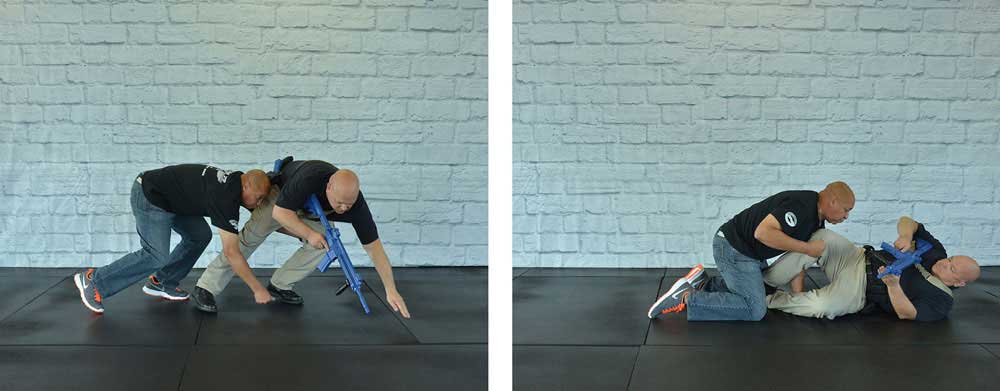
Land and fall break correctly, extending your forward arm to help absorb the impact with the ground. Be sure to angle your lead hand and wrist properly not to injure yourself on impact as you break your fall. Immediately on touching the ground, turn onto your back. As you do so, raise your topside knee to instantly transition to the foreleg brace position.

As you turn, insert your bottom leg’s foot against the assailant’s hip to keep the assailant momentarily at bay. Bring your weapon to bear and disengage from the assailant while establishing a solid shooting platform to use your primary or secondary weapon.
Long-Gun Retention against a Nine O’Clock Grab Attempt
If your long gun is slung and your arms are down, the assailant may or may not be able to get his arms around you. It depends on a few variables, including your recognition and reaction to his incoming grab, how wide you are with your gear, and how long the assailant’s arms are. In any event, you must focus on not allowing the assailant to secure any kind of hold on your long gun. Similar to the previous weapon-retention tactics, by denying the assailant any control, you can counterattack and then create space to place your long gun online. Immediately turn to face the assailant to use the long gun in a hot- or cold-weapon capacity.

The long gun’s grips are designed for you to maintain control. The assailant will have a difficult time holding on to it if you forcefully rotate the weapon clockwise.

Continue to rotate the long gun clockwise to clear it.

Create separation and a clear field of fire.